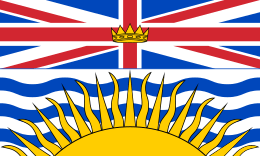Vancouver Canucks
The Vancouver Canucks are a professional ice hockey team based in Vancouver. They compete in the National Hockey League (NHL) as a member of the Pacific Division of the Western Conference. The Canucks play their home games at Rogers Arena, formerly known as General Motors Place and nicknamed The Garage, which has an official capacity of 18,910. Travis Green is the head coach and Jim Benning is the general manager.
| Vancouver Canucks | |
|---|---|
 | |
| Conference | Western |
| Division | Pacific |
| Founded | 1945 (PCHL) 1970 (as NHL expansion team) |
| History | Vancouver Canucks 1945–1952 (PCHL) Vancouver Canucks 1952–1970 (WHL) Vancouver Canucks 1970–present (NHL) |
| Home arena | Rogers Arena |
| City | Vancouver, British Columbia |
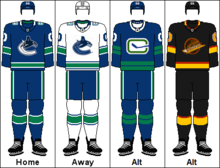 | |
| Colours | Blue, green, white[1][2] |
| Media | Sportsnet Pacific Sportsnet One Sportsnet 650 |
| Owner(s) | Canucks Sports & Entertainment (Francesco Aquilini, Chairman) |
| General manager | Jim Benning |
| Head coach | Travis Green |
| Captain | Bo Horvat |
| Minor league affiliates | Utica Comets (AHL) Kalamazoo Wings (ECHL) |
| Stanley Cups | 0 |
| Conference championships | 3 (1981–82, 1993–94, 2010–11) |
| Presidents' Trophy | 2 (2010–11, 2011–12) |
| Division championships | 10 (1974–75, 1991–92, 1992–93, 2003–04, 2006–07, 2008–09, 2009–10, 2010–11, 2011–12, 2012–13) |
| Official website | nhl |
The Canucks joined the league in 1970 as an expansion team along with the Buffalo Sabres. In its NHL history, the team has advanced to the Stanley Cup Finals three times, losing to the New York Islanders in 1982, the New York Rangers in 1994 and the Boston Bruins in 2011. They have won the Presidents' Trophy in back-to-back seasons as the team with the league's best regular season record in the 2010–11 and 2011–12 seasons. They won three division titles as a member of the Smythe Division from 1974 to 1993, and seven titles as a member of the Northwest Division from 1998 to 2013. The Canucks, along with fellow expansion team, the Buffalo Sabres, are the two oldest teams to have never won the Stanley Cup.[3]
The Canucks have retired six players' jerseys in their history—Pavel Bure (10), Stan Smyl (12), Trevor Linden (16), Markus Naslund (19), Daniel Sedin (22) and Henrik Sedin (33); all but Bure and Daniel Sedin have served as team captain. Smyl has the distinction of being the only Canuck to have his jersey number retired at their former arena, the Pacific Coliseum.
History
Background and establishment
The first professional ice hockey team based in Vancouver were the Vancouver Millionaires, formed by Frank and Lester Patrick. Established in 1911, the Millionaires were one of three teams in the new Pacific Coast Hockey Association. To accommodate the Millionaires, the Patrick brothers directed the building of the Denman Arena, which was known at the time as the world's largest artificial ice rink.[4] The arena was later destroyed in a fire in 1936. The Millionaires played for the Stanley Cup five times, winning over the Ottawa Senators in 1915 on home ice.[5] It marked the first time the Stanley Cup was won by a West Coast team in the trophy's history.[5] Absorbed by the Western Canada Hockey League in 1924, the team continued operations until folding at the end of the 1925–26 WHL season.
From 1926 to 1970, Vancouver was home to only minor league teams. Most notably the present-day Canucks' minor league predecessor (also known as the Vancouver Canucks) played from 1945 to 1970 in the Pacific Coast Hockey League and the Western Hockey League.
NHL application
With the intention of attracting an NHL franchise, Vancouver began the construction of a new modern arena, the Pacific Coliseum, in 1966 (with the arena opening in January 1968).[6] The WHL's Canucks were playing in a small arena at the time, the Vancouver Forum, situated on the same Pacific National Exhibition grounds as the Coliseum. Meanwhile, a Vancouver group led by WHL Canucks owner and former Vancouver mayor Fred Hume made a bid to be one of the six teams due to join the league in 1967, but the NHL rejected their application.[7] Bid leader Cyrus McLean called the denial a "cooked-up deal", referring to several biases that factored against them. Speculation long abounded afterwards that the bid was hindered by Toronto Maple Leafs president Stafford Smythe; after a failed Vancouver-based business deal, he was quoted as saying that the city would not get an NHL franchise in his lifetime. Additionally, along with the Montreal Canadiens, Smythe purportedly did not wish to split Canadian Broadcasting Corporation (CBC) hockey revenues three ways rather than two.[8] There were reports at the time, however, that the group had made a very weak proposal in expectation that Vancouver was a lock for one of the new franchises.
Less than a year later, the Oakland Seals were in financial difficulty and having trouble drawing fans. An apparent deal was in place to move the team to Vancouver, but the NHL did not want to see one of their franchises from the expansion of 1967 move so quickly and vetoed the deal. In exchange for avoiding a lawsuit, the NHL promised Vancouver would get a team in the next expansion round. Another group, headed by Minnesota entrepreneur Tom Scallen, made a new presentation and was awarded an expansion franchise for the price of $6 million (three times the cost in 1967).[9] The new ownership group purchased the WHL Canucks, and brought the team into the league with the Buffalo Sabres as expansion teams for the 1970–71 season.
In preparation for joining the NHL, the WHL Canucks had brought in players with prior NHL experience. Six of these players (John Arbour, George Gardner, Len Lunde, Marc Reaume, Ted Taylor and Murray Hall) would remain with the club for its inaugural NHL season. The rest of the roster was built through an expansion draft.
1970–1982: Early years
To fill the Canucks' roster for their inaugural season, the league held an Expansion Draft in the preceding summer. A draft lottery was held on June 9, 1970, determining who between the Canucks and Sabres would get the first selection in the Expansion Draft, as well as the 1970 NHL Amateur Draft; the Sabres won both spins. With his first selection in the Expansion Draft, Canucks General Manager Bud Poile chose defenceman Gary Doak.[10] Among the other players chosen by Vancouver were centre Orland Kurtenbach, who was named the Canucks' first captain,[11] as well as defenceman Pat Quinn, who later became the team's general manager and coach in the 1990s. Two days later, on June 11, 1970, the Canucks made defenceman Dale Tallon their first-ever Amateur Draft selection. Tallon played three seasons with the club before being traded away to the Chicago Black Hawks. By comparison, the Sabres chose centre Gilbert Perreault with the first overall selection they won from the lottery; Perreault went on to become a nine-time All-Star and member of the Hockey Hall of Fame.[12]
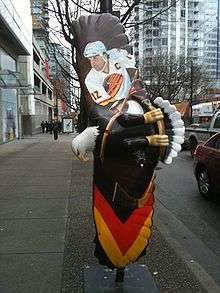
With the Canucks' roster set, the team played its inaugural game against the Los Angeles Kings on October 9, 1970. They lost the contest 3–1; defenceman Barry Wilkins scored the Canucks' lone goal in the game and first in franchise history, a backhander against goaltender Denis DeJordy.[13] Two days later, the squad recorded the first win in franchise history, a 5–3 victory over the Toronto Maple Leafs.[14]
The Canucks struggled in their early years, failing to make the playoffs in their first four seasons.[15] Placed in the competitive East Division, Poile assembled a core of players during this period led by Kurtenbach that included defencemen Tallon and Jocelyn Guevremont, as well as wingers Andre Boudrias and Dennis Ververgaert. Boudrias emerged as the team's leading point-scorer in four of their first five seasons.[16]
Prior to the 1974–75 season, Scallen and his ownership group from Minnesota sold the team to local media mogul Frank Griffiths for $9 million.[17] Also in the summer of 1974, the Canucks were re-aligned within the league and placed in the new Smythe Division. They responded with their first winning record (38 wins, 32 losses and 10 ties), backstopped by goaltender Gary "Suitcase" Smith finishing first in the Division with 86 points.[16] Making their debut in the Stanley Cup playoffs, the Canucks lost the opening series of the 1975 playoffs in five games to the Montreal Canadiens. Head Coach and General Manager Phil Maloney (the third GM in team history after Poile and Hal Laycoe) recalled the importance of a successful season for the Canucks in that year specifically, as the rival league World Hockey Association (WHA) had established another major professional team in the city, the Vancouver Blazers. Competing for the same hockey market, the Canucks emerged over the Blazers as the latter relocated to Calgary, Alberta, the following season.[18] The Canucks posted a second consecutive winning record and made the playoffs in 1975–76, but lost to the New York Islanders in a two-game preliminary series.[15] It would be another 16 years until the team would have another winning record though they made the playoffs nine times in that span.[16]
Kurtenbach retired and assumed a coaching position with Vancouver. His departure as a player marked the beginning of a seven-year period in which the Canucks had four different captains – Boudrias, Chris Oddleifson, Don Lever and Kevin McCarthy. Following the 1976–77 season, Maloney was replaced as general manager by Jake Milford, who acquired such players as Stan Smyl, Thomas Gradin, Darcy Rota, Ivan Boldirev and Richard Brodeur, a core that would lead the team throughout the 1980s.[19]
1982 Stanley Cup run
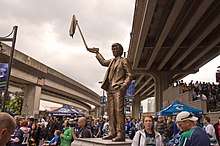
The Canucks made their first significant playoff impact in the 1982 playoffs. In their previous five playoff appearances, the team had failed to win a single series. Though the Canucks finished three games under a .500 win percentage in the 1981–82 regular season, they began gaining momentum by finishing the campaign on a nine-game unbeaten streak.[20] Meanwhile, Smyl emerged as the club's leader, replacing McCarthy as captain after the latter was sidelined with an injury late in the season (he would retain that position for a team-record eight years).[21][22] Continuing their success in the playoffs, the Canucks made the Stanley Cup Finals with a combined 11–2 record in series against the Calgary Flames, Los Angeles Kings, and Chicago Black Hawks.[15] Despite having a losing regular season record, Vancouver had home ice advantage in the first series, having finished second in the Smythe Division to the Edmonton Oilers. The Canucks also had home ice advantage during the second round series against the Kings, who upset the Oilers in the first round.
Late in Game 2 of the Conference Finals in Chicago, Vancouver Interim Head Coach Roger Neilson, frustrated with what he felt was the poor officiating in the game, placed a white towel on the end of a hockey stick and held it up in a gesture mocking surrender (waving the white flag). The players on the Canucks' bench followed suit. When the series shifted to Vancouver for the next two games, the team's fans cheered them on by waving white towels above their heads. The habit stuck, becoming an original Canuck fan tradition now seen across the league and in other sports, known as "Towel Power." The Canucks proceeded to win the series in five games, making it to the Stanley Cup Finals for the first time in their history.[23]
Entering the Finals against the New York Islanders, the Canucks were the first team from Western Canada to play for the Stanley Cup in 56 years, when the Victoria Cougars reached the 1926 Stanley Cup Finals. It also marked the first ever coast-to-coast Stanley Cup Finals.[24] Competing against the Islanders – the Stanley Cup champions of the previous two years, who had finished with 41 points more than Vancouver in the regular season standings – Vancouver took the first game to overtime. In the final minute of the extra period, Canucks defenceman and fan favourite Harold Snepsts gave the puck away with an errant pass from behind his net, leading to a Mike Bossy goal. Like the first game, the Canucks held a 3–2 lead after the first two periods in the second game, but were not able to keep their lead, and lost 6–4.[25] The Canucks were unable to complete their Cinderella run and were swept, losing their next two games by 3–0 and 3–1 scores. The 1982 playoffs proved to be the last year in which Vancouver won a playoff series until 1992.[15]
1982–1994: Decline and resurgence
After their improbable Stanley Cup run, the Canucks slipped back into mediocrity for the rest of the 1980s, making the playoffs only four times for the rest of the decade.[15] Notable players that joined the Canucks' core following the 1982 playoffs included offensively-skilled forwards Patrik Sundstrom and Tony Tanti. Beginning in 1983–84, the Canucks' scoring title was held by either Sundstrom or Tanti for four of the next five seasons. For most of the second half of the 1980s, the Canucks competed with the Los Angeles Kings for the final playoff spot in the Smythe Division. In the years in which they qualified for the playoffs, the team was eliminated in the first round by either the Edmonton Oilers (in 1985–86) or the Calgary Flames (in 1982–83, 1983–84 and the Flames championship season of 1989, which was decided in Game 7), both division rivals.[15]

Following Milford's tenure as general manager from 1977 to 1982, the position was held by Harry Neale for three years, then Jack Gordon for two. The latter was responsible for trading away power forward Cam Neely to the Boston Bruins in 1986.[26] In addition to Neely, the Canucks gave up their 1987 first round draft pick, with which the Bruins chose Glen Wesley, and in return acquired centre Barry Pederson. While Pederson collected back-to-back 70-point seasons with the Canucks in his first two seasons after the trade, he was traded away to the Pittsburgh Penguins in 1989 as his performance quickly declined.[27] Neely went on to have a Hall of Fame career with the Bruins, recording three 50-goal seasons,[28] and Wesley had a solid 20-year career.[29]
After the installation of former Canucks defenceman Pat Quinn as general manager in the summer of 1987,[30] the team underwent an immediate rebuilding process, trading away core veterans for younger prospects and players. Among the more key transactions was a deal with the New Jersey Devils, in which Sundstrom was traded away in exchange for winger Greg Adams and goaltender Kirk McLean. In addition to Quinn's trades, the team improved through the draft route with two selections, in particular. With the second overall selection in the 1988 NHL Entry Draft, the Canucks chose winger Trevor Linden from the Western Hockey League (WHL). The following year, the team made a controversial selection by choosing Russian winger Pavel Bure 113th overall. Bure was believed by most teams to be ineligible for selection that year. Consequently, his draft by the Canucks took a year to be verified by the league as team management went about procuring documents to prove his eligibility.[31]
As the decade turned, a shift in the Canucks' leadership occurred as Stan Smyl resigned his captaincy prior to the 1990–91 season due to a reduced on-ice role with the team. In his place, the Canucks implemented a rotating captaincy of Linden, Dan Quinn and Doug Lidster; of the three, Linden retained the captaincy thereafter, becoming the youngest permanent captain in team history at 21 years of age. At the end of the season, Smyl retired as the team's all-time leader in games played, goals, assists and points.[32] Led by Linden and in large part to Quinn's dealings, the Canucks rose to prominence in the early 1990s. This increased success came roughly around the time the Oilers and Flames began to sink in the standings. As a result, Vancouver won their first division title in 17 years with 42 wins, 26 losses and 12 ties during the 1991–92 season (it was also the team's first winning season since the 1975–76 season). During the campaign, the Canucks honoured Smyl, who had remained on the team as an assistant coach, by making him the first player in team history to have his jersey (number 12) retired.[32] In the 1992 playoffs, the Canucks won their first series since 1982 before being eliminated by the Oilers in the second round.[15] Quinn and Bure became the first Canucks recipients of major NHL awards in the off-season, being awarded the Jack Adams Award as the best coach (Quinn assumed a dual coaching and general managerial role starting that year) and the top rookie in the league, respectively.[33] The following year, the Canucks repeated as regular season division champions, while Bure emerged as arguably the team's first superstar with his first of back-to-back 60-goal seasons, totals which remain the highest recorded in Canucks history.[34] As the team struggled to score in the second half of the 1993–94 season, Bure recorded 49 goals in the club's final 51 games and contributed to 46.45% of his team's goals in the final 47 games of the season to carry the Canucks into the 1994 postseason. Jim Matheson of the Edmonton Journal called Bure "the NHL's best forward the last 40 games, scoring almost a goal a game."[35]
1994 Stanley Cup run
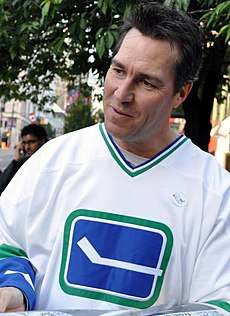
In 1994, the Canucks made their second trip to the Stanley Cup Finals, entering the playoffs as the seventh seed in the renamed Western Conference. Despite underachieving in the regular season (their points total decreased by 16 from the previous year, although they finished second in the newly-renamed Pacific Division),[16] the Canucks played well in the playoffs and embarked on another unexpected run.
Opening the playoffs with a close first-round series against the Calgary Flames, Vancouver rallied from a three-games-to-one deficit to win the series in seven contests. Games 5 through 7 were all won in overtime with goals from Geoff Courtnall, Trevor Linden and Pavel Bure.[36] The deciding seventh game featured two of the most recognizable and celebrated plays in Canucks history. With the game tied 3–3 in the first overtime, goaltender Kirk McLean made what became known thereafter as "The Save", sliding across the crease feet-first and stacking his pads on the goal line to stop Robert Reichel on a one-timer pass from Theoren Fleury. The following period, Pavel Bure received a breakaway pass from defenceman Jeff Brown before deking Calgary goaltender Mike Vernon to score and win the series. Fifteen years later, Bure's goal and McLean's save were ranked first and second in a Vancouver Sun article listing the "40 most memorable moments in team history."[37]
Following their victory over the Flames, the Canucks then upset both the Dallas Stars and Toronto Maple Leafs (both in five games) en route to the franchise's second Stanley Cup Finals appearance.[15] Forward Greg Adams sent the Canucks into the Finals with a double-overtime goal against Maple Leafs goaltender Félix Potvin in Game 5.[37] Staging the second coast-to-coast Finals in league history, the Canucks were matched against the Presidents' Trophy-winning New York Rangers. Vancouver achieved victory in Game 1 by a score of 3–2 in overtime, largely due to a 52-save performance by goaltender McLean.[38] After losing Games 2, 3 and 4, the Canucks won the next two to force a seventh game at Madison Square Garden on June 14, 1994.[15] Despite a two-goal effort (one on a shorthanded breakaway) from Linden (who was playing with cracked ribs),[39] Vancouver lost the game by a 3–2 score. The Canucks' efforts to tie the game included a post hit by forward Nathan LaFayette with just over a minute remaining in regulation.[40] The loss was followed by a riot in Downtown Vancouver, which resulted in property damage, injuries and arrests.[41] Two days after the riots, the team held a rally at BC Place attended by 45,000 fans, who congratulated the team for their effort.[42]
1994–2001: 25th Anniversary, new arena, and a new beginning
With a young core that included Linden, Bure and McLean still in their 20s after the 1994 playoffs, the Canucks appeared poised to remain contenders in the league.[40] However, the team failed to record a winning season in the six years following their Stanley Cup Finals appearance.[16] Prior to the lock-out shortened 1994–95 season, Quinn stepped down as head coach to focus on his managerial duties and was replaced by Rick Ley;[43] Vancouver finished with a .500 record that year.[16] Their elimination from the 1995 Stanley Cup playoffs in Game 4 of the second round marked the Canucks' last game played at the Pacific Coliseum,[15][44] as the team moved into the new General Motors Place (since renamed Rogers Arena), a new $160 million arena situated in Downtown Vancouver, the following season.

The Canucks made another significant move in the off-season by acquiring high-scoring Russian forward Alexander Mogilny from the Buffalo Sabres, reuniting Bure with his former CSKA Moscow and national team linemate.[45] While Mogilny became the second player in team history to record 50 goals and 100 points in a season,[34][46] chiefly playing with centre Cliff Ronning, the expected chemistry between Mogilny and Bure never materialized, with the latter suffering a season-ending knee injury early in the campaign.[47] Vancouver finished 1995–96 two games below .500 and were defeated in the first round of the playoffs by the Colorado Avalanche.[15][16] The season also marked the arrival of another future Canucks superstar, as Markus Naslund was acquired from the Pittsburgh Penguins in exchange for Alek Stojanov. The deal is regarded as one of the most lopsided trades in NHL history, as Stojanov soon became a minor-leaguer, while Naslund became the team's all-time leading goal- and point-scorer years later.[48][49][50] Despite a late season swoon, Ley was fired and replaced by Quinn down the stretch. The team limped into the playoffs, losing to the Colorado Avalanche in the first round.
In the 1996 off-season, Quinn hired Tom Renney whose tenure as the team's head coach lasted less than two seasons.[51] Despite strong performances from Mogilny and team-leading point-scorer Martin Gelinas in Bure and Linden's absence (both of whom were injured for long periods of time during the season),[16] the Canucks missed the playoffs for the first of four consecutive seasons that year.[15] Making another high-profile acquisition on July 27, 1997, the Canucks signed free agent Mark Messier to a three-year deal.[52][53] They had come close to signing Wayne Gretzky the previous summer, but were reportedly spurned away when they refused to continue negotiations and gave Gretzky an ultimatum to sign.[54]
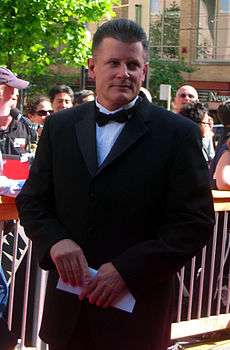
Heading into the 1997–98 season, Linden resigned his captaincy for Messier, who had developed a strong reputation as a leader, having captained the New York Rangers over the Canucks in 1994 (he also captained the Oilers to a Stanley Cup in 1990). Linden later recalled regretting the decision, feeling that Messier generated hostility and tension in the dressing room.[55] Messier later said if he could change one thing about his time in Vancouver, he would not have accepted the captaincy.[56]
The Canucks began the campaign overseas in a two-game series against the Mighty Ducks of Anaheim in Tokyo, Japan. It marked the first time in NHL history that a regular season game was held outside of North America – an effort from the league to attract attention to the sport in anticipation of the 1998 Winter Olympics, which were held in Nagano, Japan.[57] As the team's performance continued to worsen, starting the 1997–98 season with three wins in the first 16 games, Quinn was fired as general manager after ten years with the team.[54] Soon thereafter, Renney was fired and replaced as coach by Mike Keenan, reuniting him with Messier, another central figure from the Rangers' 1994 team. Keenan's hiring reportedly exacerbated tensions between groups of Canucks players and his negative relationship with Linden was given ample media attention.[58][59] Two months into his tenure with the team, his role was expanded and he was made de facto general manager. With control of player personnel, Keenan overhauled the roster, making ten trades within two months, most notably dealing Linden to the New York Islanders.[60] Although the trade was unpopular with fans, the Canucks received winger Todd Bertuzzi in return, who would later become an integral part of the team's return to success in the next decade. Defenceman Bryan McCabe was also part of the deal, who would eventually be involved in a key transaction in the 1999 NHL Entry Draft. After the Canucks finished the 1997–98 season last in the Western Conference,[61] former NHL Vice-President Brian Burke was named general manager in the summer.[62]
Suffering their worst season since 1977–78 the subsequent year,[16] Keenan was fired midway through and replaced with Marc Crawford (who had won the Stanley Cup with the Colorado Avalanche in 1996).[60] Meanwhile, Pavel Bure, unhappy in Vancouver, had withheld himself from the team and requested a trade at the beginning of the campaign. By January 1999, he was dealt to the Florida Panthers in a seven-player trade, which saw eventual five-time NHL All-Star Ed Jovanovski heading west. The trade also involved two draft picks. Finishing last in the Western Conference for a second-straight year,[63] Vancouver possessed the fourth overall pick in the 1999 NHL Entry Draft. Set on drafting highly touted Swedish forwards Daniel and Henrik Sedin, Burke orchestrated several transactions to move up to the second and third overall picks, with which he chose both players.[64]
The Canucks began to show improvement in the 1999–2000 season, finishing four points out of a playoff spot.[65] During the campaign, Mogilny was traded to the New Jersey Devils for forwards Denis Pederson and Brendan Morrison. With Bure gone and Messier in the last year of his contract, several previously under-achieving players began developing into key contributors for the team, most notably Markus Naslund and Todd Bertuzzi. In the off-season, Messier left the team and returned to the Rangers; during the team's September 2000 training camp, held in Sweden, Naslund was selected to replace Messier as captain, a position he held for seven seasons.[22] As part of the team's stay in Sweden, they played exhibition games against Swedish and Finnish teams as part of the NHL Challenge.
2001–2005: "West Coast Express" years
Under the leadership of General Manager Brian Burke and Head Coach Marc Crawford,[66] the Canucks once again became a playoff team. After qualifying for the postseason in 2001 and 2002 as the eighth and final seed in the Western Conference (losing to the eventual Stanley Cup winners Colorado Avalanche and Detroit Red Wings, respectively),[15] the Canucks became regular contenders for the Northwest Division title.
.jpg)
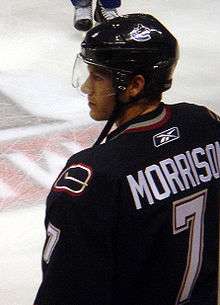
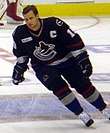
Coinciding with the team's success in the early 2000s was the rise of power forward Todd Bertuzzi and captain Markus Naslund into high-scoring wingers and NHL All-Stars. Joined by centre Brendan Morrison during the 2001–02 season, the trio were nicknamed the "West Coast Express" (after the Vancouver rail service of the same name) among Canucks fans and media.[67] Over the next three years, Naslund ranked in the top five among league scorers and was a Lester B. Pearson Award winner and Hart Memorial Trophy finalist in 2003.[68][69][70][71] Bertuzzi was also a top-five scorer in the league in 2001–02 and 2002–03.[68][69] During this span, Burke made a trade with the Washington Capitals to facilitate the return of Trevor Linden.[72] The ex-captain returned to a markedly different Canucks team with a young core consisting of the aforementioned trio, defencemen Ed Jovanovski and Mattias Ohlund, as well as goaltender Dan Cloutier.[73]
In 2002–03, the Canucks set a franchise record with a 10-game win streak but lost the division title to the Colorado Avalanche on the last day of the regular season. Individually, Naslund was surpassed the same night by Avalanche forwards Peter Forsberg and Milan Hejduk for the Art Ross Trophy and Maurice "Rocket" Richard Trophy, respectively.[74] Entering the 2003 playoffs with the fourth seed in the West, the Canucks won their first playoff series in eight years, defeating the St. Louis Blues in seven games before losing to the Minnesota Wild in the second round.[15] In both series, they were 3–1 comebacks; the Canucks rallied to beat the Blues, but lost their own 3–1 lead to the Wild, who had also come back from a 3–1 deficit in the first round, against the Avalanche.
Amidst a run for the team's first Northwest Division title the following season, the Canucks received significant media attention for their involvement in a violent on-ice attack during a game against the Avalanche. On March 8, 2004, Bertuzzi grabbed Avalanche forward Steve Moore from behind and punched him in the head. As Moore fell to the ice, Bertuzzi landed on top of him; Moore suffered three fractured neck vertebrae, facial cuts and a concussion.[75] The incident was in retaliation of a hit that Moore landed on Naslund during a previous game between the two teams.[76] For his actions, Bertuzzi was suspended by the NHL and International Ice Hockey Federation (IIHF) through to the start of the 2005–06 season. He also faced legal action in British Columbia court, while Moore filed lawsuits against him and the Canucks organization in Colorado and Ontario courts.
The Canucks went on to win their first Northwest Division title that season, but lost in the first round of the 2004 playoffs to the Calgary Flames.[15] After their elimination, Burke's contract as general manager was not renewed and he was replaced by Assistant General Manager and Director of Hockey Operations Dave Nonis. At 37 years of age, he became the youngest general manager in team history.[77] Due to the NHL lockout, the 2004–05 season was not played. Several Canucks players went overseas to Europe to play professionally, including Naslund and the Sedin twins, who all returned to their former Swedish team, Modo Hockey.[78]
2005–2011: After the lockout
Upon the resolution of the labour dispute between NHL players and owners, new gameplay rules were set in place for the 2005–06 season that were intended to benefit skilled players and generate more goal-scoring. As the Canucks' basis of success in previous seasons was built on playing a fast-paced, high-scoring style of play, expectations for the team were high going into the season.[notes 1][80] However, the team failed to qualify for the playoffs, completing the regular season ninth place in the West.[81] The first line of Naslund, Bertuzzi and Morrison suffered offensively, as all three players recorded decreased points totals.[16] Head Coach Marc Crawford later recalled the campaign as a turning point for the team's offensive leadership as the Sedin twins began their rise to stardom, matching the top line's production.[82] Crawford was fired in the off-season and replaced with Alain Vigneault, who had been coach of the team's American Hockey League (AHL) affiliate, the Manitoba Moose.[83] Three days after Vigneault's hiring, Nonis dealt Bertuzzi to the Florida Panthers, ending the "West Coast Express" era. (Naslund and Morrison would leave the team two years later.) In return, the Canucks received All-Star goaltender Roberto Luongo as part of a six-player trade.[84] With the acquisition of Luongo, Cloutier was traded away to the Los Angeles Kings.[85]

With widespread changes to team personnel in 2006–07, the Canucks won the Northwest Division title for the second time in three seasons.[16] In his first season with the Canucks, Luongo was nominated for the Hart Memorial and Vezina Trophies.[86] He also tied Bernie Parent for the second-most wins in a single-season by an NHL goaltender, with 47.[87] The Canucks opened the 2007 playoffs with a quadruple-overtime win against the Dallas Stars. Ending at the 138-minute mark, the game was the longest in club history and the sixth-longest in NHL history.[88] The Canucks also set a league record for shots against in one game, allowing 76.[89] Vancouver won the series in seven games despite a lack of goal-scoring; Stars goaltender Marty Turco recorded three shutouts in the series, becoming the only goalie to achieve the feat and still lose a series. Advancing to the second round, the team was defeated in five games by the Anaheim Ducks, who went on to win the Stanley Cup that year.[90] Following the playoffs, Head Coach Vigneault received the Jack Adams Award.[86]
Suffering numerous injuries to players in the 2007–08 season, the Canucks struggled and finished three points out of a playoff spot.[91] The final game of the season, a 7–1 loss to the Calgary Flames, marked Trevor Linden's last NHL game, as the former Canucks' all-time leading scorer retired.[92] Having missed the playoffs for the second time in three years,[15] the team underwent numerous personnel changes in the off-season. After Nonis was fired and replaced with former player agent Mike Gillis in April 2008,[93] longtime Canucks captain Markus Naslund, as well as Brendan Morrison, were let go via free agency.[94] Also in the off-season, on May 29, 2008, the Canucks lost defensive prospect Luc Bourdon to a fatal motorcycle crash near his hometown of Shippagan, New Brunswick.[95]

With Naslund's departure, Gillis announced on September 30, 2008, that Luongo had been named team captain, marking the first time since Bill Durnan of the Montreal Canadiens in 1947 that a goaltender had been named the captain of an NHL team.[96] During the ensuing season, the Canucks retired their second jersey number in team history, hanging Linden's number 16 beside Smyl's number 12 in a pre-game ceremony on December 17, 2008.[97] Later that month, the Canucks acquired unrestricted free agent Mats Sundin.[98] The arrival of the former Toronto Maple Leafs captain and 500-goal scorer in the NHL came with high expectations. However, Sundin scored at a pace below his usual pace and retired in the subsequent off-season. The team finished the regular season with another Northwest Division title and the third seed in the Western Conference.[99] In the 2009 playoffs, the Canucks swept their first round series against the St. Louis Blues (the first four-game sweep in franchise history),[100] but were defeated in six games by the Chicago Blackhawks in the second round.[101]
In the 2009–10 season, the Canucks faced the longest road trip in NHL history, with 14 games over six weeks, from January 27 to March 13, 2010.[102] The scheduling was a result of Vancouver hosting the 2010 Winter Olympics, which shut down the NHL for two weeks, facilitating General Motors Place's use for ice hockey during the games.[103] It marked the first time that an NHL market hosted an Olympics since the league allowed its players to compete in the games, beginning with the 1998 Games in Nagano. Among the several Canucks players named to their respective national teams, centre Ryan Kesler of the United States and goaltender Roberto Luongo of Canada played against each other in the gold medal game; Luongo and Team Canada emerged with the win.[104]
As the NHL season resumed, Henrik Sedin went on to become the first Canucks player to win the Art Ross and Hart Memorial Trophies as the league's leading scorer and most valuable player, respectively.[105][106] He achieved the feat with a franchise-record 112 points, surpassing Pavel Bure's mark of 110 set in 1991–92.[46] Vancouver won the Northwest Division title and finished third in the Western Conference for the second-straight year. They opened the playoffs by defeating the sixth-place Los Angeles Kings in six games, but were once again eliminated by Chicago, who went on to win the Stanley Cup that year, the following round in six games.[107]
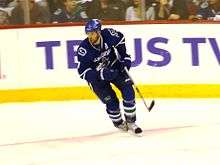
The 2010–11 season began on October 9, 2010, with a pre-game ceremony to commemorate the team's 40-year anniversary. Henrik Sedin was officially named in the ceremony as the team's new captain, replacing Roberto Luongo, who had relinquished his captaincy in the off-season.[108] The Canucks played the Los Angeles Kings, their first opponent in their inaugural season in 1970; both teams wore their original uniforms used in the Canucks' inaugural game. Throughout the season, the Canucks continued to celebrate their 40th anniversary with the creation of the "Ring of Honour", a permanent in-arena display commemorating their most significant players from past years. Four players were inducted during the campaign – Orland Kurtenbach, Kirk McLean, Thomas Gradin and Harold Snepsts. In December 2010, the Canucks also honoured Markus Naslund by retiring his number 19 jersey. Naslund had retired two years after leaving the Canucks in 2008.
During the second half of the campaign, the Canucks pulled ahead in their battles for the Western Conference and Presidents' Trophy titles with the Detroit Red Wings and Philadelphia Flyers, respectively, widening the gap as the season closed.[109][110] On March 29, 2011, the Canucks clinched first place in the West for the first time in team history.[111] Two days later, they accomplished another first by securing the Presidents' Trophy.[112] Finishing with 54 wins and 117 points, the 2010–11 team broke the previous Canuck records in both categories by significant margins. Individually, numerous Canucks players had career years. Daniel Sedin won the Art Ross Trophy with a league-leading 104 points, marking the first time in NHL history that two brothers won the award in back-to-back years. Meanwhile, Ryan Kesler tied Daniel Sedin for the team goal-scoring lead, with 41 goals. In goal, Roberto Luongo and rookie backup Cory Schneider captured the William M. Jennings Trophy for recording the lowest team goals against average (GAA) in the NHL.
2011 Stanley Cup run
Entering the 2011 Stanley Cup playoffs, the Canucks were paired with the eighth-seeded and defending Stanley Cup champion Chicago Blackhawks, who had eliminated Vancouver in the previous two years. While Vancouver initially took a 3–0 lead in the series, Chicago came back to also win three straight games and force the series into a Game 7. Luongo, who had a history of struggling against the Blackhawks, was pulled in Games 4 and 5; he also began Game 6 on the bench in favour of Cory Schneider before returning as the starter in Game 7. In the deciding game, Vancouver held a 1–0 lead with less than two minutes remaining in regulation when they gave up a shorthanded goal to Chicago captain Jonathan Toews. Forced into overtime, winger Alexandre Burrows scored his second goal of the game following a failed clearing attempt by Chicago defenceman Chris Campoli to win the series.
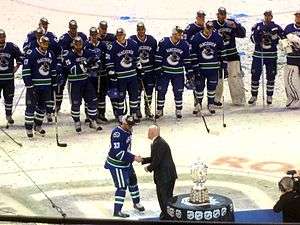
In the Conference Semi-finals, the Canucks faced the defensive-minded Nashville Predators, led by goaltender Pekka Rinne. Of the 14 goals Vancouver scored in the low-scoring series, Canucks centre Ryan Kesler registered a point in 11 of them, helping the Canucks defeat the Predators in six games. Facing the San Jose Sharks in the Conference Finals, captain Henrik Sedin led the Canucks with 12 points in the five-game series. Vancouver defeated San Jose four-games-to-one with a double-overtime winner from defenceman Kevin Bieksa in the fifth game.
Advancing to the Stanley Cup Finals for the first time since 1994, the Canucks opened the fourth round against the Boston Bruins with a 1–0 win in Game 1. Winger Raffi Torres scored the winning goal with 18.5 seconds remaining. The following game, the Canucks won 3–2 in overtime with Burrows scoring the winner 11 seconds into the extra frame, making it the second fastest overtime goal in Stanley Cup Finals history.[113] As the series shifted from Rogers Arena to TD Garden for Games 3 and 4, Boston tied the series with 8–1 and 4–0 victories. Game 3 marked the highest score by one team in a Finals game since the Colorado Avalanche defeated the Florida Panthers in 1996.[114] During the contest, the Bruins lost first-line forward Nathan Horton for the remainder of the series when he suffered a serious concussion from a controversial hit by Canucks defenceman Aaron Rome, who received a four-game suspension as a result.[115] Returning to Vancouver for Game 5, the Canucks won 1–0 with a goal from late-season acquisition Maxim Lapierre in the third period.[116] With an opportunity to win the Stanley Cup in Boston, Vancouver lost Game 6 by a 5–2 score. The Bruins' first four goals occurred in a span of four minutes and 14 seconds during the first period, setting a Finals record for the fastest four goals scored by a team (surpassing the previous mark of five minutes and 29 seconds set by the Montreal Canadiens in 1956).[117] Hosting Game 7, the Canucks were shut-out 4–0 as Boston won their first Stanley Cup in 39 years, setting off riots and looting in downtown Vancouver, repeating the events of 17 years earlier.[118]
2011–2014: Decline of the Gillis era
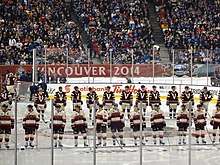
During the season-opening game against the Pittsburgh Penguins on October 6, 2011, a tribute video was staged by the fans in Rogers Arena congratulating the Canucks for their record-setting season and for making the Stanley Cup Finals. The team also honoured the late Rick Rypien, who died by suicide during the off-season, on August 15. For the rest of the season, the players wore decals on their helmets saying "37 RYP." The Canucks were strong contenders for much of the 2011–12 season, and clinched both the Western Conference and Presidents' Trophy, for the second consecutive year, in their last game of the season. Despite projections for another Stanley Cup run at the outset of the 2012 playoffs, the Canucks were eliminated in five games to eventual Cup champion Los Angeles Kings.
Prior to the start of the 2012–13 season, the league's collective bargaining agreement (CBA) expired. Unable to agree on a new CBA, the NHL enacted a lock-out on September 15, 2012. The lock-out continued on for 119 days, which resulted in the need for a shortened season.[119][120] The Canucks wore Vancouver Millionaires replica jerseys on March 16, 2013, to celebrate the 100-year anniversary of the Millionaires.
Vancouver finished the year winning their fifth consecutive Northwest Division title, but were swept in the first round of the playoffs by the San Jose Sharks.[121] Vigneault and his coaching staff were fired at the end of the season, and replaced by John Tortorella.[122]
Not long after Tortorella was hired, Cory Schneider was traded to the New Jersey Devils. The Canucks participated in their first outdoor NHL game on March 2, 2014, a match against the Ottawa Senators at BC Place. The event was titled the 2014 Heritage Classic.[123] Luongo was traded back to the Panthers during the season, while the team failed to make the playoffs for the first time in six years.[124][125] This saw Gillis fired and Linden named president of hockey operations; Tortorella was also relieved as coach after his one season.[126]
2014–present: The Benning era
On May 21, 2014, Jim Benning was announced as general manager, having previously served as assistant general manager of the 2011 Boston Bruins championship team that had beaten the Canucks three years prior.[127] On June 23, 2014, Willie Desjardins was named the 18th head coach of the Canucks.[128] The team underwent a series of changes under the new management: veteran forward Ryan Kesler was traded to the Anaheim Ducks, and defenceman Jason Garrison was traded to the Tampa Bay Lightning,[129][130] while Ryan Miller and Radim Vrbata were signed as free agents.[131][132] This season saw the team honour former general manager and head coach Pat Quinn, following his death, by renaming a city street after him (Pat Quinn Way) as well as having his family participate in a pregame ceremonial puck drop. The Canucks finished second in the Pacific Division in the 2014–15 season, reaching the 100 point plateau for the ninth time in franchise history. They faced the Calgary Flames in the first round of the playoffs, losing in six games.
As the team fared poorly throughout the 2016–17 season, more veteran players were traded: Alex Burrows and Jannik Hansen were dealt in an effort to rebuild.[133] On March 25, 2017, the Canucks' 2015 first round pick Brock Boeser made his NHL debut in his home state of Minnesota.[134] Desjardins and his coaching staff, with the exception of assistant coach Doug Jarvis, were let go at the end of the season, replaced by Travis Green who coached their AHL affiliate in Utica.[135][136] They also added Nolan Baumgartner, Newell Brown, and Manny Malhotra.[137]
The 2017–18 season was another poor year for the Canucks, but rookie Boeser was a bright spot for the team. Despite an injury late in the season, Boeser's 29 goals and 55 points in 62 games were enough to place him second in Calder Memorial Trophy voting for rookie of the year.[138] Longtime Canucks Daniel and Henrik Sedin played their final game on April 7, 2018, against the Edmonton Oilers. On June 5, 2018, longtime Canucks' public address announcer John Ashbridge died, having worked in his capacity with the franchise since 1987.[139] During the offseason, Linden stepped down as president of hockey operations.[140]
The 2018–19 season saw the debut of the Canucks' 2017 first-round draft pick, Elias Pettersson. Pettersson broke the Canucks' record for points by a rookie, set by Ivan Hlinka (1981–82) and matched by Pavel Bure (1991–92), and finished with 66 points to lead all NHL rookies, winning the Calder Trophy.[141][142]
The franchise celebrated its 50th season in the NHL, the 2019–20 season, with a ceremony at the home opener on October 9, 2019. Bo Horvat was named the 14th captain in team history,[143] following a 1-year hiatus without a captain with the retirement of the long-time captain Henrik Sedin. The 2019-20 season also saw the rookie campaign of Quinn Hughes, who finished the regular season with 8 goals, 45 assists for 53 points in 68 games, finishing top three in Calder voting. On February 12, 2020, Daniel and Henrik Sedin's numbers 22 and 33 were raised to the rafters before a game against the Chicago Blackhawks.[144] On March 12, 2020, the Canucks and the NHL's season were suspended due to the COVID-19 pandemic.[145] The Canucks won their first postseason series in 9 years on August 7, 2020, following the NHL's return to play format. They defeated the Minnesota Wild 3 games to 1 in the best of five qualifying round.
Team information
Home arenas

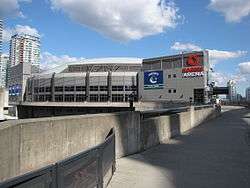
The Canucks play their home games at Rogers Arena. The stadium opened in 1995 as General Motors Place, and seats up to 18,890 for Canucks games. Rogers Arena was also the 2010 Winter Olympics' ice hockey venue, where it was temporarily named Canada Hockey Place.[146] The arena is owned and operated by Canucks Sports & Entertainment. Before moving to Rogers Arena, the Canucks played their home games at Pacific Coliseum in Hastings Park for 25 years. The arena currently holds 16,281 for ice hockey, though capacity at its opening was 15,713. During the 2010 Olympics, it was the venue for figure skating and short track speed skating. The Pacific Coliseum was also the home of the Western Hockey League (WHL)'s Vancouver Giants from 2001 to 2016.
Logos and jerseys
The team has gone through four primary logos and six major uniform designs over the years, with numerous minor changes to each, in addition to several alternate logos and jerseys.

The team's first NHL jerseys, worn from the inaugural season of 1970–71 (modified for the 1972–73 season) until the end of the 1977–78 season, featured a hockey stick in the shape of a shallow "V" superimposed on a blue rink-shaped rectangle forming the letter "C", designed by North Vancouver artist Joe Borovich.[147] A modified version of this logo is still in use, as a shoulder patch on the team's current jerseys and as the primary logo of their alternate jerseys.
In 1978, aiming for a more aggressive image, the organization asked San Francisco-based design agency Beyl & Boyd to design new uniforms. These consisted of a huge, yellow, red-orange and black striped "V" coming down from the shoulders (suggesting "victory", according to its designers). Hockey writer Stephen Cole described it as looking like "a punch in the eye". The colour of the home jerseys changed from white to yellow with the logo and uniform change. The "Flying V" theme, which included several slight modifications over the years, was abandoned in 1985, to feature the team's emblem on the front rather than the "V" (the emblem had previously been worn only on the sleeves; the V's would appear on the shoulders from 1985 to 1989). The logo consisted of the word "Canucks" in a diagonal slant as part the blade of a skate and was designed by San Francisco graphic artist Mike Bull. The logo, with its laser-like design, was sometimes referred to as the "Star Wars" logo, the "waffle iron", the "plate of spaghetti", and most commonly as the "Flying Skate."
The yellow home jerseys were scrapped in 1989 in favour of more conventional white ones, and the triangular shoulder stripes which adorned the post-"V" jerseys were discarded as well. The new incarnation was worn from 1989 to 1992, when a subtle change was made – and went largely unnoticed for the rest of the jersey's lifespan. The orange was changed to red, and the deep "gold" colour was changed to a much brighter yellow, reportedly because jersey-maker CCM no longer produced the required hues. In 1996, an alternate jersey was introduced, retaining the "Flying Skate" logo, but using a salmon colour graduating to black near the bottom. In 1997 the Canucks unveiled a new logo, in which a Haida-style orca breaking out of a patch of ice forms a stylized "C." The logo has been much-maligned, accused of being a blatant reference to their parent company, Orca Bay (now Canucks Sports and Entertainment). At the time, General Manager Pat Quinn discussed wanting to have a West Coast colour scheme, and overall West Coast themes in the logo; the colour scheme included blue, red and silver. Beginning in 2001, an alternate jersey was utilized, with contrasting shoulder patches and a blue-to-maroon graduated colour in the body. In 2006, these gradient-coloured alternate jerseys were officially replaced with the popular, royal blue "Stick-in-Rink" uniforms from the 1970s.
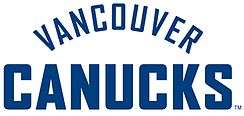
Little more than halfway through the 2006–07 season, the Canucks announced that they would be changing their jerseys once again. The new uniform was unveiled prior to training camp, on August 29, 2007. It featured the same orca design present on their previous jerseys, but the colour scheme was changed to their "retro" colours of royal blue and kelly green. Additionally, the word "Vancouver" was added to the chest area above the orca. This move was seen as a way to connect the NHL Canucks' uniform to that of the WHL team, whose members wore uniforms with the word "Canucks" along the top in a similar arched design. The actual jerseys themselves were changed to the Rbk Edge design, along with all other teams in the NHL. The introduction was largely greeted with disappointment from fans and sports commentators, who criticized the uniforms for looking like a "copy and paste" of those from the past. The Vancouver Sun described the new look as "decidedly unpopular."[148]
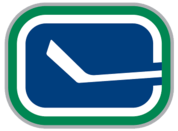
On November 14, 2008, prior to their Sport Celebrities Festival, the Canucks released their new RBK Edge Third Jersey. While staying with the colours of Vancouver, and combining the old with the new, the jersey looks very similar to their home jersey. The modernized "Stick-in-Rink" logo unveiled the previous year on the shoulder of the main jerseys is used as the main crest. On the shoulder, a "V" with the head of Johnny Canuck on top is used. This is the first time in team history since joining the NHL that Johnny Canuck has appeared on a Vancouver uniform. Sports Illustrated rated it 13th overall out of the 19 third jerseys released for the 2008 season.[149]
On opening night October 9, 2010, the Canucks revealed jerseys they would wear for select games during their 40th Anniversary season. They look exactly like the jerseys the team wore in their early years, only with the addition of Reebok manufacturing the jerseys. The jerseys sport a 40th Anniversary patch on the upper-right chest commemorating their 40th season. Just like the early years, they also bear no player names, only numbers, with permission from the NHL.
On August 13, 2015, the Canucks announced that they would be wearing their 1990s Flying Skate jerseys for a February 13, 2016 game against the Toronto Maple Leafs to honour the 20th Anniversary of Rogers Arena. They attempted to do this in the previous season to honour Pat Quinn, but were unsuccessful.[150] The 1990s jerseys will be seen again for select games in the 2019–20 season (the design was chosen via an online fan vote over two other throwback jerseys) to coincide with the team's 50th anniversary.[151]
On June 14, 2019, the Canucks updated their primary uniforms. The "Vancouver" script was removed while the modern "stick-in-rink" logo was modified with white as the main colour. A new "Heritage" uniform was also released, featuring design elements inspired from their inaugural season uniforms.[152]
Mascot
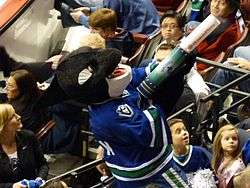
The Vancouver Canucks' mascot is an anthropomorphic killer whale (orca) named Fin the Orca. He is often seen banging a First Nations drum or skating around during intermissions firing t-shirts out of a compressed air cannon. On occasion, "smoke" also comes out of the blowhole on his head. Fin is known for his "chomping" where he bites the heads of fans.
Two fans of the Canucks became unofficial mascots of the team at the end of the 2009–2010 season, donning zentai-style, skin-tight green bodysuits in slightly different shades of green as The Green Men, and have been known to accompany the team on road games, as they did in the 2011 Stanley Cup Finals to the TD Garden against the Boston Bruins. On September 5, 2012, as an acknowledgement of their rising popularity, ESPN inducted The Green Men into the "Hall of Fans", a semi-satirical take on a Hall of Fame.[153] In November 2014, the Green Men announced that 2014–15 would be their final season.[154]
Media
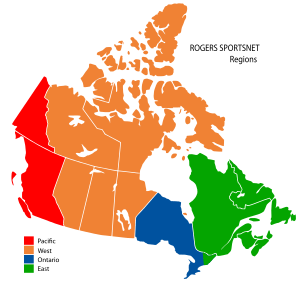
After a relationship with CKNW stretching since the Canucks joined the NHL in 1970, the Canucks entered into a new radio broadcast deal in 2006 with CKST – an AM sports/talk station. John Shorthouse continues to call the play-by-play, as he has since 1999, though with his role on the Canucks' television broadcasts becoming more prominent in recent years, he is replaced for approximately 50 games per season by Jon Abbott. He is joined with colour commentary by Dave Tomlinson, who has been with the broadcasts since 2010.[155] The games aired on 14 stations across British Columbia. On March 9, 2017, it was announced that Rogers Media had acquired radio rights to the Canucks under a 5-year deal to begin in the 2017–18 season.[156] On April 25, 2017, Rogers announced that it would acquire CISL from Newcap Radio and convert it to a sports radio format to serve as team flagship.[157]
Sportsnet and Rogers hold a monopoly on all television broadcasts of the Canucks; regional games are aired by Sportsnet Pacific, and occasionally on the overflow channel Sportsnet Canucks.[158][159] Sportsnet had held the television rights to the team since 1998.[156]
Ownership
The initial owners were Tom Scallen's Medicor group. In 1972, hints of impropriety were circulating about Scallen. He was charged with stock fraud and spent the last two years of his Canuck ownership in prison.[160] In 1974, Scallen and Medicor sold the team to media executive Frank Griffiths. From 1988 to 1997, the Vancouver Canucks were owned by local businessman and philanthropist Arthur Griffiths, who had inherited ownership from his father, Frank. However, he was forced to sell his majority interest in the Canucks after overextending his resources trying to build a new arena, GM Place (currently known as Rogers Arena). As a result, he sold his majority share to American billionaire John McCaw, Jr..
On November 17, 2004, the Aquilini Investment Group, headed by Francesco Aquilini, purchased a 50% share in Orca Bay Sports and Entertainment (the owners of both the Canucks franchise and Rogers Arena) from John McCaw, Jr. Prior to the sale, Aquilini and two business partners, Tom Gaglardi and Ryan Beedie, had negotiated with Orca Bay for several months without concluding an agreement. In January 2005, Gaglardi and Beedie filed a lawsuit against Aquilini and Orca Bay, alleging that Aquilini and Orca Bay had acted in bad faith in concluding a deal using information obtained from their joint offer.
On November 8, 2006, Aquilini, along with his brothers Roberto and Paolo, purchased the remaining 50% of the Vancouver Canucks and Rogers Arena from McCaw.[161][162]
In May 2007, Gaglardi and Beedie's civil lawsuit over Aquilini's purchase reached the Supreme Court of British Columbia. The court ruled for Aquilini, on January 10, 2008. The court held that there was no legal partnership between Aquilini, Beedie, and Gaglardi, and that McCaw was free to sell the team to anyone he wished.[163]
On January 29, 2008, the company responsible for operating the Vancouver Canucks and Rogers Arena, changed its name from Orca Bay Sports and Entertainment to Canucks Sports & Entertainment.
Minor league affiliates
Top affiliates
| 1970–71 to 1971–72 | Rochester Americans (AHL) |
| 1972–73 to 1974–75 | Seattle Totems (WHL, CHL) |
| 1975–76 to 1977–78 | Tulsa Oilers (CHL) |
| 1978–79 to 1981–82 | Dallas Black Hawks (CHL) |
| 1982–83 to 1987–88 | Fredericton Express (AHL) |
| 1988–89 to 1991–92 | Milwaukee Admirals (IHL) |
| 1992–93 to 1993–94 | Hamilton Canucks (AHL) |
| 1994–95 to 1999–00 | Syracuse Crunch (AHL) |
| 2000–01 | Kansas City Blades (IHL) |
| 2001–02 to 2010–11 | Manitoba Moose (AHL) |
| 2011–12 to 2012–13 | Chicago Wolves (AHL) |
| 2013–14 to present | Utica Comets (AHL) |
Secondary affiliates
| 1987–88 | Flint Spirits (IHL) |
| 1991–92 | Columbus Chill (ECHL) |
| 2002–03 to 2005–06 | Columbia Inferno (ECHL) |
| 2006–07 to 2010–11 | Victoria Salmon Kings (ECHL) |
| 2011–12 to 2014–15 | Kalamazoo Wings (ECHL) |
| 2016–17 | Alaska Aces (ECHL) |
| 2017–18 to present | Kalamazoo Wings (ECHL) |
Season-by-season record
This is a partial list of the last five seasons completed by the Canucks. For the full season-by-season history, see List of Vancouver Canucks seasons.
Note: GP = Games played, W = Wins, L = Losses, T = Ties, OTL = Overtime Losses, Pts = Points, GF = Goals for, GA = Goals against
| Season | GP | W | L | OTL | Pts | GF | GA | Finish | Playoffs |
| 2015–16 | 82 | 31 | 38 | 13 | 75 | 191 | 243 | 6th, Pacific | Did not qualify |
| 2016–17 | 82 | 30 | 43 | 9 | 69 | 182 | 243 | 7th, Pacific | Did not qualify |
| 2017–18 | 82 | 31 | 40 | 11 | 73 | 218 | 264 | 7th, Pacific | Did not qualify |
| 2018–19 | 82 | 35 | 36 | 11 | 81 | 225 | 254 | 5th, Pacific | Did not qualify |
| 2019–20 | 69 | 36 | 27 | 6 | 78 | 228 | 217 | 4th, Pacific | TBD |
Players
Current roster
Updated July 28, 2020[164][165]
Retired numbers
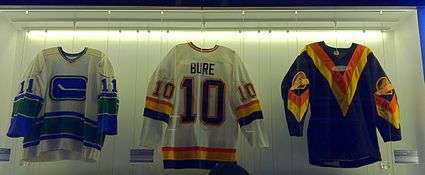
| No. | Player | Position | Career | No. retirement |
|---|---|---|---|---|
| 10 | Pavel Bure | RW | 1991–1998 | November 2, 2013 |
| 12 | Stan Smyl | RW | 1978–1991 | November 3, 1991 |
| 16 | Trevor Linden | RW | 1988–1998 2001–2008 | December 17, 2008 |
| 19 | Markus Naslund | LW | 1996–2008 | December 11, 2010 |
| 22 | Daniel Sedin | LW | 2000–2018 | February 12, 2020 |
| 33 | Henrik Sedin | C | 2000–2018 | February 12, 2020 |
- Notes
- Bure wore number 10 for five of his seven seasons in Vancouver. He wore number 96 during the 1995–96 and 1996–97 seasons before returning to number 10 during the 1997–98 season.
- The NHL retired Wayne Gretzky's #99 for all its member teams at the 2000 NHL All-Star Game.[167]
Numbers taken out of circulation
Although not officially retired, the following numbers are no longer issued by the Canucks:
- 11 – Wayne Maki, LW, 1970–1973, taken out of circulation following his death from brain cancer on May 1, 1974. Chris Oddleifson (C, 1974–1976) and Mark Messier (C, 1997–2000) are the only Canucks players to have worn it since.[168]
- 28 – Luc Bourdon, D, 2006–2008, taken out of circulation following his death in a motorcycle crash on May 29, 2008.[169][170]
- 37 – Rick Rypien, C, 2005–2011, taken out of circulation following his death from suicide on August 15, 2011.[170]
Hall of Famers
Several former players and builders from the Vancouver Canucks have been inducted into the Hockey Hall of Fame. Five former players have been incucted, and five builders (executives, general managers, head coaches, and owners).
| Vancouver Canucks Hall of Famers | ||||
|---|---|---|---|---|
| Hockey Hall of Fame Inductees | ||||
| Players | ||||
| Pavel Bure | Igor Larionov | Mark Messier | Cam Neely | Mats Sundin |
| Builders | ||||
| Frank Griffiths |
Jake Milford |
Roger Neilson |
Bud Poile |
Pat Quinn |
Ring of Honour inductees
The Vancouver Canucks Ring of Honour is a collection of permanent in-arena displays, that commemorates individuals that made an impact with the franchise. Inductees to the Ring of Honour include:
- Orland Kurtenbach, C, 1970–1974, inducted October 26, 2010.
- Kirk McLean, G, 1987–1998, inducted November 24, 2010.
- Thomas Gradin, C, 1978–1986, inducted January 24, 2011.
- Harold Snepsts, D, 1974–1984; 1988–1990, inducted March 14, 2011.
- Pat Quinn, D, 1970–1972; President & General manager, 1987–1997; Head Coach, 1991–1994; 1996, inducted April 13, 2014.
- Mattias Ohlund, D, 1997–2009, inducted December 16, 2016.
- Alex Burrows, RW, 2005–2017, inducted December 3, 2019.
Team captains
There have been 14 Canucks players who have served as the captain. The franchise's first captain was Orland Kurtenbach, who captained the team until his retirement in 1974.[171] The longest-tenured Canucks captains have been Stan Smyl and Henrik Sedin, who each served as captain for eight seasons; each were also the only captains to have spent their entire NHL career with the Canucks.[172][173] Swedish winger Markus Naslund, who captained for seven seasons, was the first non-Canadian to have captained the Canucks.
Though goaltenders are not permitted to act as captains during games, Roberto Luongo served as the captain from 2008 to 2010, but because of the NHL rule against goaltender captains, the league did not allow Luongo to serve as on-ice captain.[174][175] In his place, the three alternate captains were responsible for dealing with officials during games. They also handled ceremonial face-offs.[175] Luongo was not permitted to wear the "C" on his jersey. Instead, he incorporated it into the artwork on the front of one of his masks, which he occasionally wore for the early months of the 2008–09 season.[176]
- Orland Kurtenbach, 1970–1974
- Andre Boudrias, 1975–1976
- Chris Oddleifson, 1976–1977
- Don Lever, 1977–1979
- Kevin McCarthy, 1979–1982
- Stan Smyl, 1982–1990
- Dan Quinn, Doug Lidster and Trevor Linden, 1990–1991 (tri-captains)
- Trevor Linden, 1991–1997
- Mark Messier, 1997–2000
- Markus Naslund, 2000–2008
- Roberto Luongo, 2008–2010
- Henrik Sedin, 2010–2018
- Bo Horvat, 2019–present
Draft picks
The Canucks selected Dale Tallon, a defenceman from the Toronto Marlboros with their first pick, second overall in the 1970 NHL Amateur Draft. In 1978, they drafted Stan Smyl from the New Westminster Bruins. Ten years later, the Canucks also drafted Trevor Linden from the Medicine Hat Tigers in 1988.[177] The Canucks have had 13 top-five draft picks in franchise history, but have never had the first overall pick. The Canucks are one of the two franchises in the NHL to have drafted two twin brothers in the same year. They drafted Daniel Sedin second overall and Henrik Sedin third overall in 1999.[178] Two players from British Columbia have been selected by the Canucks in the first round of an NHL Entry Draft: Cam Neely in 1983 and Jake Virtanen, taken 6th overall in 2014.[179]
Franchise scoring leaders
These are the top-ten point-scorers in franchise history. Figures are updated after each completed NHL regular season.
- * – current Canucks player
Note: Pos = Position; GP = Games Played; G = Goals; A = Assists; Pts = Points; P/G = Points per game
|
|
|
Head coaches
There have been 19 head coaches for the Canucks. The franchise's first head coach was Hal Laycoe, who coached the Canucks for two seasons. Alain Vigneault coached the most games of any Canucks head coach with 540 games, and has the most points all-time with the Canucks with 683, from the 2006–07 season through the 2012–13 season. He is followed by Marc Crawford, who has 586 points all-time with the Canucks. Vigneault also has the most points in a season of any Canucks coach, with 117 in the 2010–11 season. Roger Neilson is the only Hockey Hall of Fame inductee to coach the Canucks. Quinn and Vigneault are the only two Canucks head coaches to win a Jack Adams Award with the team. Bill LaForge, who coached the start of the 1984 season, has the fewest points with the Canucks, with 10. Harry Neale served the most terms as head coach of the Canucks with three while Pat Quinn served two.
The current head coach is Travis Green, who served in the same position with the Canucks' AHL affiliate, the Utica Comets.
Awards and trophies
NHL
Budweiser NHL Man of the Year Award
Lester B. Pearson Award / Ted Lindsay Award
NHL Plus/Minus Award
- Marek Malik: 2003–04 (shared with Martin St. Louis of the Tampa Bay Lightning)
- Trevor Linden: 2007–08 (shared with Vincent Lecavalier of the Tampa Bay Lightning)
Scotiabank Fan Fav Award
NHL General Manager of the Year Award
All-Star
First All-Star Team
Second All-Star Team
Franchise
Franchise individual records
As of the 2018–19 season
- Skaters
- Most games played in a career: Henrik Sedin, 1,330 (2000–2018)
- Most goals in a career: Daniel Sedin, 393 (2000–2018)
- Most assists in a career: Henrik Sedin, 830 (2000–2018)
- Most points in a career: Henrik Sedin, 1,070 (2000–2018)
- Most penalty minutes in a career: Gino Odjick, 2,127 (1990–1998)
- Most goals in a season: Pavel Bure, 60 (1992–93 and 1993–94)
- Most assists in a season: Henrik Sedin, 83 (2009–10)
- Most points in a season: Henrik Sedin, 112 (2009–10)
- Highest plus/minus in a season: Christian Ehrhoff, 36 (2009–10); Daniel Sedin, 36 (2009–10), tied
- Most penalty minutes in a season: Donald Brashear, 372 (1997–98)
- Most points in a season, defenceman: Doug Lidster, 63 (1986–87)
- Most points in a season, rookie: Elias Pettersson, 66 (2018–19)
- Fastest goal recorded by a Canuck: Alexandre Burrows, 6 seconds (2012–13)
- Goaltenders
- Most games played in a career, goaltender: Kirk McLean, 516 (1987–1997)
- Most wins in a career: Roberto Luongo, 252 (2006–2014)
- Most shutouts in a career: Roberto Luongo, 38 (2006–2014)
- Most wins in a season: Roberto Luongo, 47 (2006–07)
- Most shutouts in a season: Roberto Luongo, 9 (2008–09)
- Lowest GAA in a season (min. 30 GP): Cory Schneider, 1.96 (2011–12)
- Best SV% in a season (min. 30 GP): Cory Schneider, .937 (2011–12)
Notes
- For example: decreased tolerance for impeding a player as he is skating, four-foot increase length-wise in the offensive zones, abolishment of the two-line pass rule (i.e. passing the puck from the defending zone to the opposing side of centre) and a decrease in goaltending equipment size.[79]
References
- Gibson, John (October 26, 2007). "New Look Canucks". Canucks.com. NHL Enterprises, L.P. Retrieved December 8, 2017.
- "Company Directory" (PDF). 2016–17 Vancouver Canucks Media Guide. NHL Enterprises, L.P. October 5, 2016. Retrieved December 8, 2017.
- Ferreras, Jesse (June 12, 2019). "The Canucks are now among the NHL's 2 oldest existing teams without a Stanley Cup". globalnews.ca. Retrieved June 14, 2019.
- "The History of Metropolitan Vancouver". VancouverHistory.ca. Retrieved May 25, 2011.
- Stephan Müller (December 2005). International Ice Hockey Encyclopaedia: 1904– 2005. BoD – Books on Demand. p. 465. ISBN 9783833441899. Retrieved May 26, 2011.
- "Pacific Coliseum". Canadian Broadcasting Corporation. January 13, 2010. Archived from the original on March 24, 2010. Retrieved May 25, 2011.
- Punch Imlach; Scott Young (January 1, 1986). Heaven and Hell in the NHL. Formac Publishing Company. p. 19. ISBN 978-0-88780-141-9. Retrieved May 26, 2011.
- Total Hockey, ed. Dan Diamond (1998), Andrews McMeel, p. 251.
- Rossiter 1994, p. 27.
- Rossiter 1994, pp. 27–28.
- Gary Mason (September 1, 2003). Oldtimers: On the Road with the Legendary Heroes of Hockey, Including Bobby Hull, Darryl Sittler, Marcel Dionne, Reggie Leach and Tiger Williams. Greystone Books. p. 120. ISBN 978-1-55054-890-7. Retrieved May 26, 2011.
- Rossiter 1994, p. 28.
- Justin Bedall (November 15, 2004). Vancouver Canucks: Heartstopping Stories from Canada's Most Exciting Hockey Team. Heritage House Publishing Co. pp. 20–. ISBN 978-1-55153-792-4. Retrieved May 26, 2011.
- Media Guide 2008, p. 146.
- Media Guide 2008, p. 235.
- Media Guide 2008, pp. 146–82.
- Rossiter 1994, p. 33.
- Rossiter 1994, p. 39.
- Rossiter 1994, p. 47.
- Rossiter 1994, p. 57.
- "Blues looking for good luck". Pittsburgh Press. March 21, 1982. Retrieved May 2, 2010.
- "Henrik Sedin named Canucks' captain". The Sports Network. October 9, 2010. Archived from the original on October 11, 2013. Retrieved October 16, 2010.
- Rossiter 1994, p. 58.
- "Stanley Cup champions and finalists". National Hockey League. Archived from the original on June 29, 2009. Retrieved May 31, 2011.
- Rossiter 1994, p. 61.
- Rossiter 1994, p. 62.
- "Barry Alan Pederson". Hockey Hall of Fame. Retrieved June 3, 2011.
- "Cam Neely Biography". Hockey Hall of Fame. Retrieved June 3, 2011.
- "Glen Edwin Wesley". Hockey Hall of Fame. Retrieved March 12, 2012.
- Stan Fischler; Shirley Fischler (March 2, 2003). Who's Who in Hockey. Andrews McMeel Publishing. p. 362. ISBN 978-0-7407-1904-2. Retrieved May 26, 2011.
- Rossiter 1994, p. 71.
- "Stan Philip Smyl". Hockey Hall of Fame. Retrieved May 2, 2010.
- "The Russian Rocket". Sports Illustrated. December 7, 1992. Archived from the original on December 8, 2012. Retrieved June 24, 2009.
- "Regular Season – Vancouver Canucks – All Skaters – Single Season Leaders For Team – Career Goals". National Hockey League. Retrieved May 27, 2011.
- Matheson, Jim (April 16, 1994). "WESTERN CONFERENCE PREVIEW: [Final Edition]". Edmonton Journal.
- Rossiter 1994, pp. 15–16.
- Pap, Elliott (September 30, 2009). "40 most memorable moments in team history". The Vancouver Sun. Canada. Archived from the original on September 5, 2012. Retrieved May 31, 2011.
- Rossiter 1994, p. 87.
- Don Weekes; Kerry Banks (August 23, 2010). Hockey's Top 100: The Game's Greatest Goals. Greystone Books. p. 50. ISBN 978-1-55365-660-9. Retrieved May 26, 2011.
- Rossiter 1994, p. 103.
- "4 Canadian Sports Riots". Maclean's.
- "45,000 Canuck fans pack stadium to thank players". Waterloo Record. June 17, 1994. Retrieved June 3, 2011.
- "Sports people: Hockey; Pat Quinn Turns Over Coaching Duties". The New York Times. Associated Press. August 11, 1994. Retrieved May 31, 2011.
- "Stanley Cup Playoffs NHL Report: Blackhawks, Wings Sweep Into Finals". Newsday. Long Island, New York. May 28, 1995. Retrieved May 31, 2011.
- Miles, Gary (July 9, 1995). "Mogilny trade steals spotlight". The Day. Connecticut. Retrieved May 31, 2011.
- "Regular Season – Vancouver Canucks – All Skaters – Single Season Leaders For Team – Career Points". National Hockey League. Retrieved May 31, 2011.
- "Severe knee injury ends season for Canucks' Bure; Surgery scheduled soon". The Spokesman-Review. Spokane, Washington. November 12, 1995. Retrieved May 31, 2011.
- Montgomery, Ted (February 13, 2008). "Eight of the NHL's worst trades of all time". USA Today. Retrieved March 9, 2008.
- Robinson, Alan (April 20, 2006). "GM Craig Patrick leaves Penguins after 17 years". USA Today. Retrieved July 25, 2008.
- "What was the worst trade in Penguins history?". Pittsburgh Post-Gazette. March 3, 2010. Retrieved October 16, 2010.
- "Vancouver Canucks Coach Register". Hockey-Reference.com. Retrieved May 31, 2011.
- Archived June 10, 2015, at the Wayback Machine
- Jeff Z. Klein (October 26, 2004). Messier. Doubleday Canada. p. 325. ISBN 978-0-7704-2908-9. Retrieved May 26, 2011.
- Brown, Frank (November 9, 1997). "Quinn Top Canuckle-Head". Daily News. New York. Retrieved May 31, 2011.
- "Say it Aint So". Sports Illustrated. August 8, 2001. Retrieved May 26, 2010.
- Messier, Mark. "Mark Messier here to take your questions". Reddit. Retrieved January 10, 2014.
- Teaford, Elliott (October 4, 1997). "Ducks, Canucks Warm Up Japan for Five-Ring Circus". Los Angeles Times. Retrieved September 1, 2011.
- Vecsey, George (December 11, 1998). "Spots of The Times; Here's How A Captain Operates". The New York Times. Retrieved February 21, 2008.
- Pratt, Dave (February 5, 2008). "Linden outlasts 'darkest time' trade from Canucks". The Province. Archived from the original on November 4, 2012. Retrieved February 21, 2008.
- "Hockey; Canucks Dismiss Keenan and Bring In Crawford". The New York Times. January 25, 1999. Retrieved May 31, 2011.
- "1997–1998 Regular Season". National Hockey League. Retrieved May 31, 2011.
- "Plus: Hockey – Vancouver; Burke Rejoins Canucks as G.M." The New York Times. June 23, 1998. Retrieved May 31, 2011.
- "1998–1999 Regular Season". National Hockey League. Retrieved May 31, 2011.
- "Sedin twins' dynamics changed draft". Sports Illustrated. Associated Press. June 26, 1999. Retrieved May 31, 2011.
- "1999–2000 Regular Season". National Hockey League. Retrieved May 31, 2011.
- Patrick Thornton (February 11, 2010). Sports Law. Jones & Bartlett Learning. p. 336. ISBN 978-0-7637-3650-7. Retrieved May 26, 2011.
- "Emotional time for Naslund". The Province. CanWest News. November 27, 2007. Archived from the original on June 28, 2011. Retrieved July 25, 2008.
- "2001–2002 Regular Season All Skaters Summary Total Points". National Hockey League. Retrieved June 10, 2011.
- "2002–2003 Regular Season All Skaters Summary Total Points". National Hockey League. Retrieved June 10, 2011.
- "2003–2004 Regular Season All Skaters Summary Total Points". National Hockey League. Retrieved June 10, 2011.
- "Markus Naslund". Hockey Hall of Fame. Retrieved June 10, 2011.
- "Trevor Linden". Hockey Hall of Fame. Retrieved June 10, 2011.
- "Former Canuck captain Markus Naslund says having jersey retired an honour". The Hockey News. July 8, 2010. Archived from the original on March 13, 2012. Retrieved October 22, 2010.
- "Canucks lose Northwest, now face Blues". Canadian Broadcasting Corporation. April 6, 2003. Retrieved May 26, 2018.
- "Steve Moore still recovering from Bertuzzi hit". CTV.ca. March 9, 2007. Archived from the original on March 18, 2007. Retrieved January 7, 2011.
- Mossman, John (February 18, 2004). "Naslund gets his bell rung". USA Today. Retrieved May 27, 2010.
- "Nonis is club's youngest-ever GM". ESPN. Associated Press. May 8, 2004. Retrieved June 10, 2011.
- "2004–05 Modo Hockey [SEL]". Hockeydb. Retrieved April 18, 2010.
- "New NHL will be faster, more skill-oriented". Amarillo Globe-News. July 25, 2005. Archived from the original on June 22, 2011. Retrieved October 21, 2010.
- "Season preview: Canucks seek Cup as NHL breaks ice". The Seattle Times. October 5, 2005. Retrieved October 16, 2010.
- "2005–2006 Regular Season". National Hockey League. Retrieved June 10, 2011.
- Pierre LeBrun (February 3, 2010). "Surprised by Sedin? You shouldn't be". ESPN. Retrieved April 19, 2010.
- "Vigneault hired as Canucks' head coach". USA Today. Associated Press. June 20, 2006. Retrieved June 10, 2011.
- Luongo signs four-year, $27 million deal with Canucks. [Retrieved January 15, 2009]. ESPN.
- "Kings acquire goalie Cloutier from Canucks". ESPN. July 5, 2006. Retrieved March 1, 2011.
- Brehm, Mike (June 15, 2007). "NHL awards analysis". USA Today. Retrieved June 10, 2011.
- "Regular Season Goalie Goalie Single Season Leaders For Team Wins". National Hockey League. Retrieved June 10, 2011.
- "Marathon win in a whale of a wakeup call". The Vancouver Sun. Canada. April 12, 2007. Archived from the original on June 2, 2008. Retrieved January 20, 2009.
- "Addition of Luongo not enough for Canucks". USA Today. May 6, 2007. Retrieved June 10, 2011.
- "2007 NHL Playoffs Summary". Hockey-Reference.com. Retrieved June 10, 2011.
- "2007–2008 Regular Season". National Hockey League. Archived from the original on June 6, 2011. Retrieved June 10, 2011.
- "Linden set to call it a career". Rogers Sportsnet. The Canadian Press. June 10, 2008. Archived from the original on July 9, 2008. Retrieved June 10, 2011.
- "Vancouver Canucks – News: Vancouver Canucks Name Mike Gillis General Manager". National Hockey League. Archived from the original on June 30, 2008. Retrieved April 25, 2008.
- Allen, Kevin (July 10, 2008). "Demitra heads to Vancouver with two-year, $8M deal". USA Today. Retrieved June 10, 2011.
- "Canucks rookie Bourdon, 21, killed in motorcycle crash". ESPN. Associated Press. May 29, 2008. Retrieved May 29, 2008.
- "Goaltenders who have served as NHL Captains". HockeyGoalies.org. Archived from the original on September 21, 2008. Retrieved September 30, 2008.
- Kreiser, John (2008). "Linden prepares for his big night". National Hockey League. Retrieved December 17, 2008.
- "Sundin giving Canucks $1.4m discount". The Vancouver Sun. Canada: Postmedia News. December 19, 2008. Archived from the original on December 20, 2008. Retrieved December 19, 2008.
- "2008–2009 Regular Season". National Hockey League. Retrieved June 10, 2011.
- "Burrows, Luongo Lead Canucks Sweet of Blues". The Sports Network. April 22, 2009. Archived from the original on October 11, 2013. Retrieved December 9, 2018.
- "Kane's Hat Trick Helps Hawks Eliminate Canucks with 7–5 Win". The Sports Network. May 12, 2009. Archived from the original on October 11, 2013. Retrieved December 9, 2018.
- "Olympics put Canucks on record road grind". CBC Sports. The Canadian Press. July 16, 2009. Retrieved May 26, 2018.
- Sekeres, Matthew (July 16, 2009). "Canucks take one for the Olympic team". The Globe and Mail.
- "Luongo silences his critics". Canadian Broadcasting Corporation. The Canadian Press. March 1, 2010. Archived from the original on March 5, 2010. Retrieved June 11, 2011.
- Brad Ziemer (June 23, 2010). "The Hart of the matter: Sedin is NHL's MVP". The Vancouver Sun. Canada: Postmedia News. Retrieved June 24, 2010.
- Gordon McIntyre (April 11, 2010). "Canucks Henrik Sedin wins Art Ross Trophy as NHL scoring champion". The Province. Vancouver: Postmedia News. Archived from the original on April 13, 2010. Retrieved April 11, 2010.
- "2010 NHL Playoffs Summary". Hockey-Reference.com. Retrieved June 11, 2011.
- "Henrik Sedin named Canucks team captain". The Vancouver Canucks Official Web site. National Hockey League. October 9, 2010. Retrieved October 10, 2010.
- McIntyre, Iain (January 3, 2011). "Grinders pitch in to keep roll going". The Vancouver Sun.
- Carchidi, Sam (January 3, 2011). "Flyers get first win in Detroit since 1988". Philadelphia Inquirer. p. E1.
- Ziemer, Brad (March 29, 2011). "Canucks clinch top seed in West with win over Predators". The Vancouver Sun. Archived from the original on April 1, 2011. Retrieved March 29, 2011.
- "Canucks Game Day: Canucks can clinch Presidents' Trophy tonight". The Vancouver Sun. March 31, 2011. Archived from the original on April 9, 2011. Retrieved April 1, 2011.
- "Burrows' OT goal just misses record". National Hockey League. Retrieved June 5, 2011.
- Roarke, Shawn (June 7, 2011). "Bruins play 'Boston hockey,' claw back into series". National Hockey League. Retrieved June 10, 2011.
- "Vancouver's Rome suspended for four games for late hit – 2011 Stanley Cup Final – Canucks v Bruins". National Hockey League. June 7, 2011. Retrieved June 7, 2011.
- Rosen, Dan (June 11, 2011). "Canucks win Game 5, one win away from Cup". National Hockey League. Retrieved June 11, 2011.
- Rosen, Dan (June 14, 2011). "Bruins chase Luongo, force Game 7 with 5–2 win". National Hockey League. Archived from the original on June 15, 2011. Retrieved June 14, 2011.
- "Krawalle überschatten Vancouvers Finalpleite". Die Welt (in German). June 16, 2011. Retrieved June 18, 2011.
- Hackel, Stu (January 6, 2013). "Tentative deal reached to end lockout". Archived from the original on January 8, 2013. Retrieved January 6, 2013.
- "2012–13 NHL regular season schedule". National Hockey League. Retrieved January 13, 2013.
- "Canucks take Northwest title again". Fox Sports. April 23, 2013. Retrieved June 26, 2013.
- "Canucks hire fired Rangers coach John Tortorella". Yahoo! News. June 25, 2013. Retrieved June 26, 2013.
- "Senators score four unanswered goals to beat Canucks at Heritage Classic". The Globe and Mail. Retrieved May 31, 2015.
- "Roberto Luongo says Heritage Classic snub led to Vancouver exit". Canadian Broadcasting Corporation. Retrieved May 31, 2015.
- Anaheim vs Vancouver - Recap - NHL - Sports. Canadian Broadcasting Corporation. Retrieved April 12, 2014.
- "Tortorella & Sullivan relieved of coaching duties". Vancouver Canucks. Retrieved May 1, 2014.
- http://canucks.nhl.com/club/news.htm?id=720223
- http://canucks.nhl.com/club/news.htm?id=723453
- "Ducks Acquire Kesler and a 2015 Third-Round Pick from Vancouver in Exchange for Bonino, Sbisa and 2014 First and Third-Round Picks". June 27, 2014. Retrieved September 17, 2014.
- "Canucks acquire 50th overall pick from Lightning". June 27, 2014. Retrieved September 17, 2014.
- "CANUCKS SIGN UFA G MILLER TO THREE-YEAR, $18M CONTRACT". July 1, 2014. Archived from the original on August 30, 2014. Retrieved September 17, 2014.
- "Canucks sign Radim Vrbata to 2-year deal". July 2, 2014. Retrieved September 17, 2014.
- Botchford, Jason. "The day the world, and the Canucks, officially flipped". The Province. Retrieved March 2, 2017.
- "Canucks' Brock Boeser scores game-winner in NHL debut". CBC Sports. March 25, 2017. Retrieved May 4, 2019.
- "Canucks relieve Willie Desjardins of duties". Vancouver Canucks. April 10, 2017.
- "Travis Green named Canucks head coach". National Hockey League. April 26, 2017. Retrieved April 26, 2017.
- "Canucks complete 17-18 coaching staff". National Hockey League. June 7, 2017. Retrieved July 13, 2017.
- "Mathew Barzal wins Calder Memorial Trophy as NHL's top rookie - Sportsnet.ca". sportsnet.ca. Retrieved May 4, 2019.
- Press, Canadian. "Longtime Canucks PA announcer John Ashbridge dead at 71". Sportsnet. Retrieved June 6, 2018.
- Friedman, Elliotte. "Trevor Linden is stepping down in VAN". Elliotte Friedman. Retrieved July 26, 2018.
- Biech, Ryan (March 19, 2019). "Elias Pettersson sets Canucks rookie scoring record". Canucksarmy. Retrieved May 4, 2019.
- "Elias Pettersson: Calder nominee". National Hockey League. Retrieved May 4, 2019.
- "Bo Horvat named 14th captain in Vancouver Canucks history - Sportsnet.ca". www.sportsnet.ca. Retrieved April 6, 2020.
- Schram, Carol (February 13, 2020). "Canucks honour legends Daniel, Henrik Sedin with jersey retirement ceremony". CBC Sports. Retrieved April 5, 2020.
- "NHL statement on coronavirus". NHL.com. Retrieved April 6, 2020.
- "Canada Hockey Place - 2010 Vancouver Olympics". The New York Times. Retrieved May 4, 2019.
- "MacIntyre, Iain. "Canucks wardrobe: A history from hideous to splendour," Vancouver Sun, Monday, February 15, 2016". Archived from the original on February 2, 2019. Retrieved January 28, 2019.
- Hansen, Darah (August 29, 2007). "Uniform unveiled". The Vancouver Sun. Archived from the original (– Scholar search) on May 9, 2011.
- "Vancouver Canucks". CNN. Retrieved May 27, 2010.
- "Canucks looked at dusting off the 90s flying skate jersey for Pat Quinn night". canucksarmy.com. CanucksArmy. Retrieved July 25, 2016.
- Blackburn, Pete (August 13, 2018). "LOOK: Vancouver Canucks are bringing back the Flying Skate as a throwback jersey". CBS Sports. Retrieved August 15, 2018.
- "Canucks Reveal Heritage Jersey for 50th Season". Vancouver Canucks. June 14, 2019. Retrieved June 15, 2019.
- "Canucks' Green Man inducted into Hall of Fans". Sportsnet.ca. Retrieved September 2, 2017.
- "Canucks' Green Men retiring at the end of the season". Retrieved May 31, 2015.
- Macintyre, Ian (July 28, 2010). "Tom Larscheid leaving Canucks' broadcast booth". The Vancouver Sun. Archived from the original on September 3, 2010.
- "Canucks leaving TSN 1040 after signing five-year radio deal with Rogers Sportsnet". The Province. Retrieved March 18, 2017.
- "Sportsnet to launch Vancouver all-sports radio station this fall". Sportsnet. April 25, 2017. Retrieved April 25, 2017.
- Canucks release 2010.11 broadcast schedule, Vancouver Canucks press release, September 13, 2010. Retrieved September 13, 2010.
- "Canucks announce new television partnership with Rogers Sportsnet ONE". National Hockey League. July 28, 2010. Retrieved July 28, 2010.
- https://www.theglobeandmail.com/news/british-columbia/tom-scallen-the-american-who-delivered-the-canucks-to-canadians/article581730
- TSN.ca, Aquilini group buys rest of Canucks Archived October 17, 2007, at the Wayback Machine
- Business in Vancouver November 14–20, 2006, issue 890, p. 1.
- Court feud yields a rare look into Canucks' backroom dealing Archived January 2, 2016, at the Wayback Machine By Ian Mulgrew. Vancouver Sun, B1. May 8, 2007.
- "Vancouver Canucks Roster". National Hockey League. Retrieved July 11, 2020.
- "Vancouver Canucks Hockey Transactions". The Sports Network. Retrieved March 3, 2020.
- De Vera, Alfred; Maniago, Stephanie; Brown, Ben; Brunwell, Chris, eds. (2016). "Vancouver Canucks 2016.17 Media Guide" (PDF). Vancouver Canucks. pp. 204–205. Retrieved January 13, 2018.
- "Perfect setting: Gretzky's number retired before All-Star Game". CNN Sports Illustrated. Associated Press. February 6, 2000. Archived from the original on November 12, 2013. Retrieved June 9, 2014.
- Botchford, Jason (September 10, 2014). "Botchford: Wayne Maki a fighter to the end". Canada.com. Retrieved May 5, 2017.
- "Vancouver Canucks By The Numbers: Nos. 4 & 28 – Luc Bourdon". The Canuck Way. July 7, 2015. Retrieved November 5, 2018.
- "NHL retired jerseys: Teemu Selanne leads Pacific Division locks". Sporting News. July 28, 2013. Retrieved November 5, 2018.
- "Orland Kurtenbach". Hockey Hall of Fame. Archived from the original on December 5, 2007. Retrieved February 22, 2009.
- "Stan Smyl Statistics". Hockey-Reference.com. Sports Reference LLC. Retrieved February 22, 2009.
- "Henrik Sedin Statistics". Hockey-Reference.com. Sports Reference LLC. Retrieved January 23, 2011.
- "Rule 6 – Captain and Alternate Captains". National Hockey League. Retrieved February 23, 2009.
- "Canucks name goaltender Luongo as team captain". The Sports Network. September 30, 2008. Archived from the original on December 2, 2008. Retrieved February 23, 2009.
- Luongo sports captain's 'C' on goalie mask. CBC Sports. October 5, 2008 [Retrieved May 26, 2018].
- "Statistics – All-time Stats". National Hockey League. Archived from the original on July 4, 2008. Retrieved July 5, 2008.
- "Futures". National Hockey League. Archived from the original on January 28, 2001. Retrieved July 5, 2008.
- "Comet Tales: Virtanen's Unexpected Debut – Utica Comets Official Website]publisher=Utica Comets". Archived from the original on May 31, 2015. Retrieved May 31, 2015.
- Rossiter, Sean (1994). Vancouver Canucks: The Silver Edition. Vancouver: Opus Productions. ISBN 0-921926-12-X.
- Vancouver Canucks Media Guide 2008–09. Vancouver Canucks. 2008.
Further reading
- Bedall, Justin (2004). Vancouver Canucks: Heartstopping Stories from Canada's Most Exciting Hockey Team. Altitude Pub. Canada. ISBN 1-55153-792-3.
.svg.png)
